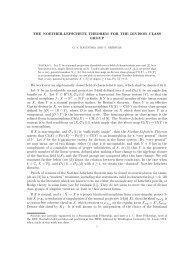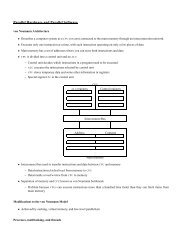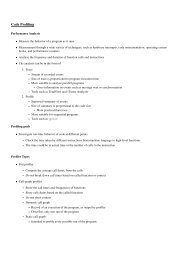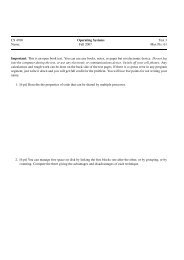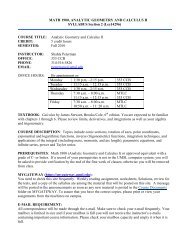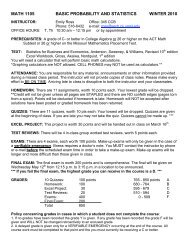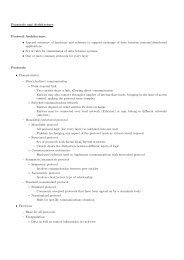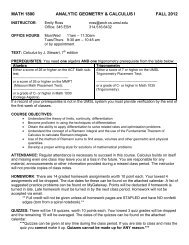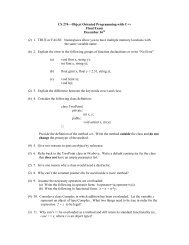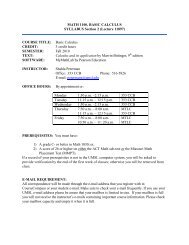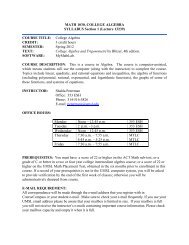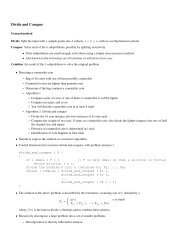here - UMSL : Mathematics and Computer Science - University of ...
here - UMSL : Mathematics and Computer Science - University of ...
here - UMSL : Mathematics and Computer Science - University of ...
Create successful ePaper yourself
Turn your PDF publications into a flip-book with our unique Google optimized e-Paper software.
IEEE TRANS. SIGNAL PROC. 9<br />
w<strong>here</strong> I 0 (ω) is defined by (15), <strong>and</strong> that the 3 × 3 matrix 1 √<br />
3<br />
[I 0 (ω + 2πM −T η 0 ), I 0 (ω + 2πM −T η 1 ), I 0 (ω +<br />
2πM −T η 2 )] is unitary for all ω ∈ IR 2 , we know that (19) holds if <strong>and</strong> only if V (ω) is unitary for all ω ∈ IR 2 ,<br />
namely, V (ω) satisfies<br />
V (ω)V (ω) ∗ = I 3 , ω ∈ IR 2 . (21)<br />
If {p, q (1) , q (2) } is given by (18), then its polyphase matrix V (ω) is<br />
V (ω) = B n D(ω)B n−1 D(ω) · · · B 1 D(ω)B 0 .<br />
Since each D(ω) is unitary, we know that if constant matrices B k , 0 ≤ k ≤ n, are orthogonal, then V (ω) satisfies<br />
(21).<br />
Next, we consider the orthogonality <strong>of</strong> a matrix B <strong>of</strong> the from (17). To this regard, let U denote the unitary<br />
matrix:<br />
⎡<br />
⎤<br />
U =<br />
⎢<br />
⎣<br />
1 0 0<br />
0<br />
1 √2<br />
1 √2<br />
0<br />
1 √2 − 1 √<br />
2<br />
Then<br />
⎡ √ ⎤<br />
b 11<br />
UBU ∗ √ 2b12 0<br />
= ⎣ 2b21 b 22 + b 23 0 ⎦ .<br />
0 0 b 22 − b 23<br />
[ √ ]<br />
b<br />
Thus B is orthogonal if <strong>and</strong> only if 11 2b12<br />
√2b21 is orthogonal <strong>and</strong> b 22 + b 23 = ±1, which implies that<br />
b 22 + b 23<br />
b ij can be written as<br />
⎥<br />
⎦ .<br />
b 11 = s 0 cos θ, b 12 = 1 √<br />
2<br />
sin θ, b 21 = s 0<br />
√<br />
2<br />
sin θ,<br />
b 22 + b 23 = − cos θ, b 22 − b 23 = s 1 ,<br />
w<strong>here</strong> s 0 = ±1, s 1 = ±1, θ ∈ IR. Thus an orthogonal matrix B <strong>of</strong> the form (17) has one parameter. If we choose<br />
s 0 = 1, s 1 = 1 <strong>and</strong> write cos θ = 1−t2<br />
1+t<br />
, sin θ = 2t<br />
2 1+t<br />
, then we have<br />
2<br />
√<br />
b 11 = 1−t2<br />
1+t<br />
, b 2 12 = b 21 = 2t<br />
1+t<br />
, b 2 22 = t2<br />
1+t<br />
, b 2 23 = 1<br />
1+t<br />
. (23)<br />
2<br />
We have t<strong>here</strong>fore the following theorem.<br />
Theorem 1: Suppose {p, q (1) , q (2) } is given by (18). If each B k , 0 ≤ k ≤ n is <strong>of</strong> the form (17) <strong>and</strong> its entries b ij<br />
are given by (22) for some θ k , then {p, q (1) , q (2) } is an orthogonal FIR filter bank with 2-fold rotational symmetry.<br />
With such a family <strong>of</strong> orthogonal FIR filter banks, by selecting the free parameters, one can design the filters<br />
with desirable properties. Here we consider the filters based on the Sobolev smoothness <strong>of</strong> the associated scaling<br />
functions φ. We say φ to be in the Sobolev space W s for some s > 0 if φ satisfies ∫ IR 2(1 + |ω|2 ) s | ˆφ(ω)| 2 dω < ∞.<br />
To assure that φ ∈ W s , the associated FIR lowpass filter p(ω) has sum rules <strong>of</strong> certain order. p(ω) is said to have<br />
sum rule order m (with dilation matrix M) provided that p(0, 0) = 1 <strong>and</strong><br />
(22)<br />
D α 1<br />
1 Dα 2<br />
2 p(2πM −T η j ) = 0, 1 ≤ j ≤ 2, (24)<br />
for all (α 1 , α 2 ) ∈ Z 2 + with α 1 + α 2 < m, w<strong>here</strong> η j , 1 ≤ j ≤ 2, are defined by (8), D 1 <strong>and</strong> D 2 denote the<br />
partial derivatives with the first <strong>and</strong> second variables <strong>of</strong> p(ω) respectively. Under some condition, sum rule order is<br />
equivalent to the approximation order <strong>of</strong> φ, see [48]. The Sobolev smoothness <strong>of</strong> φ can be given by the eigenvalues<br />
<strong>of</strong> the so-called transition operator matrix T p associated with the lowpass filter p, see [49], [50]. The reader refers<br />
to [26] for the algorithms <strong>and</strong> Matlab routines to find the Sobolev smoothness order.<br />
We find that if the orthogonal filter bank {p, q (1) , q (2) } is given by (18) with n = 0 or n = 1, then the lowpass<br />
filter p(ω) cannot achieve sum rule order 2, <strong>and</strong> hence, the smoothness order <strong>of</strong> φ is very low. In the following<br />
two examples, we consider the filter banks with n = 2 <strong>and</strong> n = 3.<br />
Example 1: Let {p, q (1) , q (2) } be the orthogonal filter bank with 2-fold rotational symmetry given by (18) for<br />
n = 2: B 2 D 2 (M T ω)B 1 D 1 (M T ω)B 0 I 0 (ω), w<strong>here</strong> D 1 , D 2 are defined in (16), B 0 , B 1 <strong>and</strong> B 2 are orthogonal



